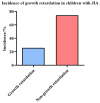Risk factors for growth retardation in children with juvenile idiopathic arthritis: a case-control study
- PMID: 39871279
- PMCID: PMC11770990
- DOI: 10.1186/s12891-024-08247-7
Risk factors for growth retardation in children with juvenile idiopathic arthritis: a case-control study
Abstract
Objective: This study aimed to investigate the role of various factors contributing to growth retardation, including nutritional intake, disease duration, and treatment history, and further identify key risk factors that may influence growth outcomes in patients with juvenile idiopathic arthritis (JIA).
Methods: Clinical data from 155 JIA children who were treated at our hospital between January 2019 and December 2022 were analyzed. The children were divided into the growth retardation group (n = 40) and the non-growth retardation group (n = 115) based on the height Z-score < -2 SD or not. The two groups were compared based on their baseline characteristics, disease-related factors, dietary habits, lifestyle, and family background. Logistic regression and receiver operating characteristic (ROC) curve analyses were employed to identify and assess the factors associated with growth retardation.
Results: Out of the 155 children, 40 (25.81%) were diagnosed with growth retardation. Children with growth retardation were more likely to have a disease duration ≥ 3 years (72.50% vs. 39.13%, P < 0.001), exercise time < 1 h/per day (68.50% vs. 33.04%, P < 0.001), glucocorticoid use (65.00% vs. 34.78%, P = 0.001), and active disease activity (72.50% vs. 37.39%, P < 0.001). These factors were identified as independent risk factors for growth retardation in multivariate analysis. The area under the curve (AUC) values for these factors ranged from 0.651 to 0.676, indicating moderate predictive accuracy. When considering all these factors together, the combined model demonstrated an AUC value of 0.702, suggesting a high predictive value.
Conclusion: The incidence of growth retardation in children with JIA is high, with factors such as disease duration, exercise time, GC treatment, clinic visits, picky eating, and disease activity contributing to its development. While each of these factors demonstrates moderate predictive value individually, their combined consideration significantly improves predictive accuracy.
Clinical trial number: Not applicable.
Keywords: Growth and development status; Growth retardation; Influencing factors; Juvenile idiopathic arthritis.
© 2024. The Author(s).
Conflict of interest statement
Declarations. Ethics and consent to participate: This study was approved to the Ethics Committee of Hebei Medical University Third Hospital (W2021-042-1) in accordance with the Declaration of Helsinki. Since this study is a retrospective analysis and the identification information of the patients and their families is anonymized, informed consent from the patients and their families is not required. Consent for publication: Not applicable. Competing interests: The authors declare no competing interests.
Figures
Similar articles
-
Growth and weight gain in children with juvenile idiopathic arthritis: results from the ReACCh-Out cohort.Pediatr Rheumatol Online J. 2017 Aug 22;15(1):68. doi: 10.1186/s12969-017-0196-7. Pediatr Rheumatol Online J. 2017. PMID: 28830457 Free PMC article.
-
Children with oligoarticular juvenile idiopathic arthritis are at considerable risk for growth retardation.J Pediatr. 2011 Nov;159(5):832-837.e1-2. doi: 10.1016/j.jpeds.2011.04.012. Epub 2011 May 31. J Pediatr. 2011. PMID: 21621220
-
Endocrine dysfunction in patients with juvenile idiopathic arthritis.Pediatr Rheumatol Online J. 2025 Apr 24;23(1):41. doi: 10.1186/s12969-025-01058-7. Pediatr Rheumatol Online J. 2025. PMID: 40275257 Free PMC article.
-
An investigation into the relationship between nutritional status, dietary intake, symptoms and health-related quality of life in children and young people with juvenile idiopathic arthritis: a systematic review and meta-analysis.BMC Pediatr. 2023 Jan 2;23(1):3. doi: 10.1186/s12887-022-03810-4. BMC Pediatr. 2023. PMID: 36593466 Free PMC article.
-
Growth abnormalities in children and adolescents with juvenile idiopathic arthritis.Rheumatol Int. 2014 Nov;34(11):1483-8. doi: 10.1007/s00296-014-3022-2. Epub 2014 Apr 24. Rheumatol Int. 2014. PMID: 24760485 Review.
Cited by
-
Facial Proportions in Stunted and Non-Stunted Children Aged 7-72 Months: A Cross-Sectional Study in Bandung, Indonesia.Children (Basel). 2025 Aug 7;12(8):1037. doi: 10.3390/children12081037. Children (Basel). 2025. PMID: 40868489 Free PMC article.
References
-
- Bansal N, Pasricha C, Kumari P, Jangra S, Kaur R, Singh R. A comprehensive overview of juvenile idiopathic arthritis: from pathophysiology to management. Autoimmun Rev. 2023;22(7):103337. - PubMed
MeSH terms
Substances
Grants and funding
LinkOut - more resources
Full Text Sources
Medical
Miscellaneous





